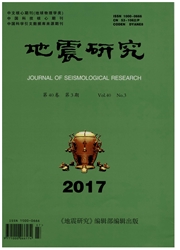

 中文摘要:
中文摘要:
在固定的坐标系下,讨论了直立长方体水平运动与其外部的重力场变化之间的关系,建立了地壳水平运动与地球外部重力场变化的数学模型。根据此模型,并参考直立长方体大小以及地形等因素,用2003—2008年GRACE(Gravity Recovery And Climate Experiment)卫星数据计算地球外部重力场变化,基于PSO算法(Particle Swarm Optimization Algorithm)反演中国西部地区地壳水平运动速率。反演结果表明:中国西部地壳水平运动具有整体由南向北、且伴有向东运动的特征;地壳水平运动表现为不均匀,除昆明区域(地壳由北向南运动)外,在南北方向上地壳水平运动速率具有从南向北逐渐递减的趋势。青藏高原南北方向运动速率为10~35mm/a,东西方向运动速率1~25mm/a;塔里木盆地南北方向运动速率5—15mm/a,东西方向运动速率4~7mm/a。
 英文摘要:
英文摘要:
The relationship between the horizontal movements of the erect cube and its exterior gravitational field chan- ges in the fixed coordinates are discussed. The mathematical model between the horizontal movements of the crust and the changes of the Earth exterior gravitational field is established. According to this model, using Gravity Recovery and Climate Experiment (GRACE) satellite's data from 2003 to 2008, we calculate the gravitation- al field changes, and inverse the velocity of the horizontal crustal movement in West China through the Particle Swarm Optimization (PSO) algorithm. The results show that there exists an overall and horizontal movement of the crust in West China from South to North with the trend of eastward movement. The velocity declines gradually from South to Noah, except Kunming region (whose crust moves from North to South). In the North-South direction and East-West direction, the velocities of horizontal crustal movement of the Qinghai-Tibet plateau are 10 -35mm/a and 1 -25mm/a respectively. In the North-South direction and East-West direction, the velocities of Tarim Basin are 5 - 15 mm/a and 4 - 7mm/a respectively.
 同期刊论文项目
同期刊论文项目
 同项目期刊论文
同项目期刊论文
 期刊信息
期刊信息
